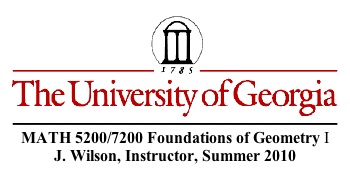

Problem Set 3.2
Problem 3.2.2
Problem 3.2.3
Problem 3.2.4
Problem 3.2.5
GSP File for Problem 3.2.5 from Nicholas Cluster
Problem 3.2.11 Leonardo da Vinci proof of the Pythagorean Theorem
Problem 3.2.12
Problem 3.2.13 Pappus's Theorem
An exploration of Pappus's Theorem
The above link will take you to another web page from EMAT 6600. It uses a JavaGSP animation to show the use of shear transformations to lead to a proof of Pappus's theorem.
Who was Pappus? This is a link to the St. Andrew's University History of Mathematics Web site. Note: This is one of many theorems in the mathematics literature that bear the name of Pappus. It is not considered his most important work.
Pappus's Theorem: Given any triangle ABC (not necessarily a right triangle). Arbitrary parallelograms are constructed on two sides AC and BC. The parallelograms have bases equal to the respective sides of the triangle; the height is arbitrary. Let D be the intersection of the outer sides of the parallelograms and segment DC.
Construct a parallelogram on AB with base AB and sides parallel to DC and equal in length to DC.
OPEN GSP File and examine the animation.
Prove that area III is equal in area to the sum of areas I and II.
If triangle ABC is a right triangle, does this prove the Pythagorean Theorem? What else is needed?
The sequence of shears:
This is the sequence of shears that Mike wanted to show in his explanation during class rather than the sequence on my GSP file. Regions I and II are transformed into equivalent areas from the first stage to the last one where it is easy to show the desired result.